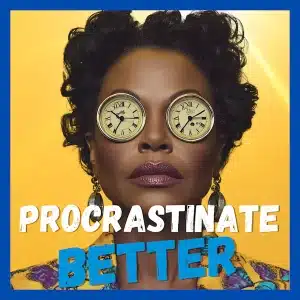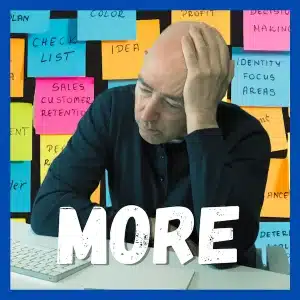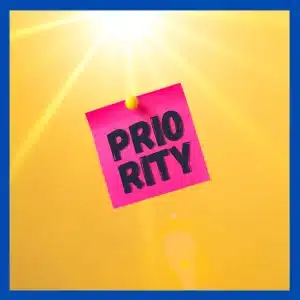How do you make money as a content creator?
This is important because if you can’t make money from your content, then you can’t devote yourself to your content.
That means you’ll become a human yo-yo – like I was with my book summary service – you’ll be working on your content creation, then you’ll have to drop that and go and do something else – do jobs for other people.
That’s the big challenge for all of us – doing things we love versus doing things for money.
In this post, I’ll focus on the one thing you must do to shift from free content to paid content – from free to fee.
And I’ll share my personal example of what I’m working on right now – turning my free video and blog posts into income-earning books.
The Crucial Concept Needed to Go from Free to Fee
I mentioned the crucial concept of going from free to fee in the previous post, Seven questions to Make Money as a Content Creator. Plus, I spoke about it in detail in the earlier one about your Service Offering.
That concept is strategic flow. It’s when you design a pathway for your audience to go from one product to another.
We’re looking for a natural upsell for your customers and clients. It’s like when you go to Mcdonald’s to buy a burger and you walk out with a meal instead.
How to Create a Clear Pathway for your Customers to Buy from You
A great way to visualize this is to use a Relationship Curve or an Ascension Marketing Curve. It’s a graph that has dollars on the vertical axis and relationships on the horizontal axis.
The principle is that as the relationship grows the potential to earn money increases.
For instance, standing at the supermarket checkout it’s easy to make an impulse buy of chocolate because it’s only a dollar or two. But if I was going to pay you $10,000 for business coaching, then I want to know, like and trust you before I pay you any money.
Free Content
You’ll notice in the diagram, that that curve doesn’t start in the corner – it starts a little along the relationship line. This is because of your free content. You’re giving away your ideas as videos or words or images to build a relationship with potential clients.
Paid Content
In the post on Service Offerings, I went into more detail about the full range of products and services you could offer. For instance, it could be books, coaching and do-it-for-you services like website design.
But in this post, I want to focus on this transition from free to paid. And to keep it simple I’ll refer to your products and services as your paid content.
The Big Question You Need to Ask to Make Money from Your Content
The big question here is: what’s different between your free and your paid content?
In other words, why would I pay you when I can access all this other content for free?
The key word here is value. Your customers and clients want value for money.
What do we mean by this?
Essentially, when you make a sale you make a trade – I’ll give you this – some money and you give me that – your product or service. For the sale to happen your customer must see that it is worthwhile – having some value or being worthy.
The Two Reasons a customer will Pay You Money
There are two fundamental reasons why any customer or client will hand over their cash:
- They want to get something
- Or they want to avoid something
It’s gain or pain.
For instance, I pay the transcription service, Otter, because they help me write my books faster and easier. For around $100 a year, I can save around 100 hours of time and effort converting my audio notes into written words. Plus, I’ve started using them to transcribe my videos to make it easy to create subtitles. That’s a big gain.
And I pay someone about $500 each year to do my tax because it saves me at least ten hours of hassle if I had to do it myself. That saves me a lot of pain.
If You don’t do this, customers won’t buy from you
While you want to have a natural or strategic flow from your free content to your paid content, you also must present a significant shift in value. If your customers don’t see the increased value, they won’t buy from you.
Last week Apple released their new iPhone 14. While it has some new features, a lot of the reviews are saying that there is not enough of a jump from the previous model to justify paying for the new phone.
The Value Jump Thought Experiment
Let’s do a thought experiment.
Here’s what I’m planning for myself in going from free content to paid content.
For each of my videos on YouTube, I also have a written blog post.My plan is to turn my content into books and ebooks. For instance, I have published ten videos and blog posts on the Content Creation Canvas. Each blog post is about 2000 words in length. This means ten posts is about 20,000 words which is the size of a small book.
The Big Question
Let’s presume you like this content and you do want access to it.
If I bundled all ten blog posts into a single pdf as an ebook, would you buy it?
Your choice is to read the content for free on my blog. But to do that you would have to go over to my website and scroll through all the pages. The comparison is to have a single neat package of the same content on your desktop ready to open anytime.
Buying the eBook is more convenient, but is that enough for you to buy it?
It’s not like its new information, it’s merely more convenient. If you did buy it, you probably wouldn’t pay very much for it.
But what if the blog posts were general principles, and the eBook was a completely new roadmap with precise steps for you to follow?
Or if the blog posts were full of words that took hours to read and the book was a series of pages with visuals like my earlier book, Weekly Done that you could scan in minutes.
That might tip the scales from free to paid. It’s enough of a shift or jump in value to make you pay for it.
This is how you need to think through your paid offers. To create your paid offers you need to compare the value to your free content.
Seven Examples of How to go from Free Content to Paid
To help you think through this, here are seven examples of value jumps for going from free to paid content.
1 From Slow to Fast
What if you could read a business book in 30 minutes instead of 4-5 hours? This was why people subscribed to my book summary service. It saved them a lot of time.
2 From General to Personal
This is how I approach my video and blog posts – given I can’t interact directly with you to ask you what you want and prefer, I provide general principles. But in my coaching, I can personalise through a one-to-one conversation. Further, given my clients want to be seen as thought leaders, they put a high value on having a personalised approach. Having a general or generic answer is not going to position them to earn the big dollars they seek.
3 From Off Track to On Track
Your blog may offer advice on what to eat to be healthy, but how would you know if you are eating well today? I use the Daily Dozen app from NutritionFacts.org to record and keep track of what goes in my mouth. This way I have a record of how well I’m eating.
4 From Tips to Steps
If your video content is filled with great tips, you might translate this into specific steps that people can follow to produce a specific result.
5 From Single to System
If you were going to buy a camera, it’s relatively easy to this camera with that one. But it’s much harder to buy a full studio setup with cameras, sound, lighting, and tripods – especially within a fixed budget. Your blog might offer individual recommendations and you could offer a paid service for full studio setups.
6 From a basic result to an advanced result
The recipes on your blog might be simple and easy such that almost anyone can make them. But your paid video cooking course might provide meal plans instead of single meals. Or they might jump into chef-quality creations.
7 From DIY to DIFY
Your blog may provide all the tips anyone would need to create their own website. But not everyone wants a DIY website and that’s why you could do well with a Do-It-For-You service.
A Simple Formula to Create Paid Content from Your Free Content
You probably noticed that I framed each of these examples as ‘from this to that’.
I suggest you think about your free to paid content in the same way because this will help you keep the jump or the contrast clear in your own mind and in the minds of potential clients.
- What does your free content provide? And what are the limits of what it can provide?
- What could your paid content provide and prevent instead?
More on how to Make Money from your Content Creation
When I created the title of this post and said ‘do this’ to make money as a content creator, I wanted to share the one thing you must do to achieve this.
And that one thing is to cause a jump in the minds of your audience, so they see a clear difference in value between your free content and your paid content.
This is important because if you can’t make this jump, you can’t make money from your content and you can’t devote yourself to your art. If you want to make your art AND make money, then make the jump.
To dive deeper into this conversation, you might also like these posts:
- Seven Questions to Make Money as a Content Creator
- How to sell your service – 13 sneaky easy ways
- Create a Service Offering You’ll Fall in Love with
Which of the seven examples could you use to make money from your content? Or perhaps there’s another one you could use?







